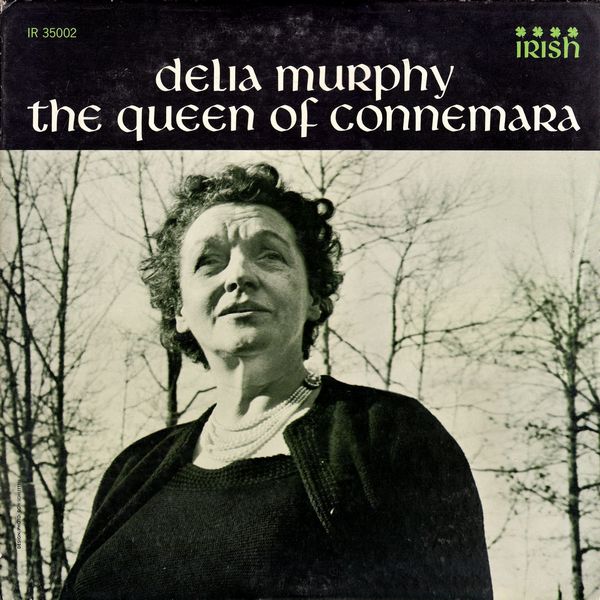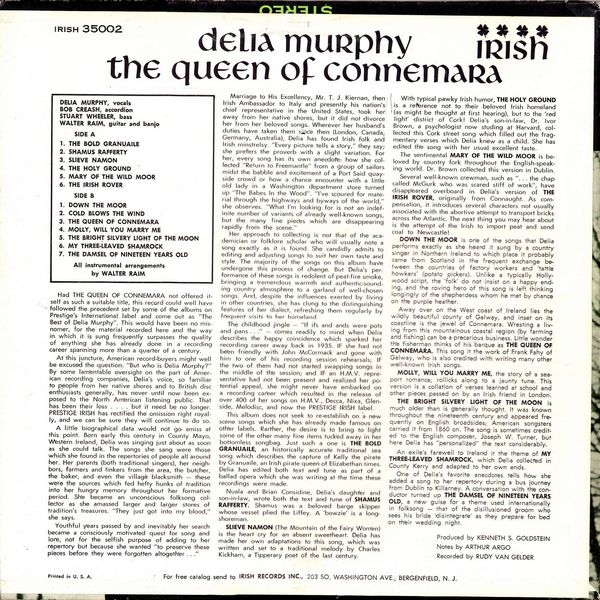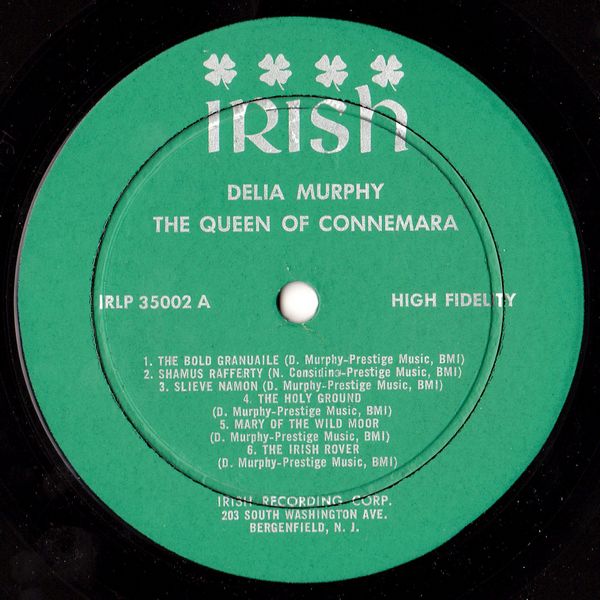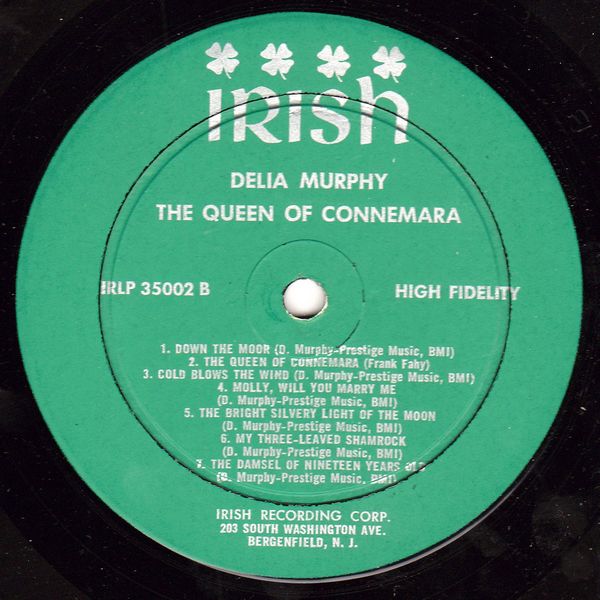
 |



|
Sleeve Notes
Had THE QUEEN OF CONNEMARA not offered itself as such a suitable title, this record could well have followed the precedent set by some of the albums on Prestige's International label and come out as "The Best of Delia Murphy". This would have been no misnomer, for the material recorded here and the way in which it is sung frequently surpasses the quality of anything she has already done in a recording career spanning more than a quarter of a century.
At this juncture, American record-buyers might well be excused the question: "But who is Delia Murphy?" By some lamentable oversight on the part of American recording companies, Delia's voice, so familiar to people from her native shores and to British disc enthusiasts generally, has never until now been exposed to the North American listening public. That has been their loss … but it need be no longer. PRESTIGE IRISH has rectified the omission right royally, and we can be sure they will continue to do so.
A little biographical data would not go amiss at this point. Born early this century in County Mayo, Western Ireland, Delia was singing just about as soon as she could talk. The songs she sang were those which she found in the repertories of people all around her. Her parents (both traditional singers), her neighbors, farmers and tinkers from the area, the butcher, the baker, and even the village blacksmith — these were the sources which fed hefty hunks of tradition into her hungry memory throughout her formative period. She became an unconscious folksong collector as she amassed larger and larger stores of tradition's treasures. "They just got into my blood," she says.
Youthful years passed by and inevitably her search became a consciously motivated quest for song and lore, not for the selfish purpose of adding to her repertory but because she wanted "to preserve these pieces before they were forgotten altogether … "
Marriage to His Excellency, Mr. T. J. Kiernan, then Irish Ambassador to Italy and presently his nation's chief representative in the United States, took her away from her native shores, but it did not divorce her from her beloved songs. Wherever her husband's duties have taken them since then (London, Canada, Germany, Australia), Delia has found Irish folk and Irish minstrelsy. "Every picture tells a story," they say; she prefers the proverb with a slight variation. For her, every song has its own anecdote: how she collected "Return to Freemantle" from a group of sailors midst the babble and excitement of a Port Said quayside crowd or how a chance encounter with a little old lady in a Washington department store turned up "The Babes In the Wood". "I've scoured for material through the highways and byways of the world," she observes. "What I'm looking for is not an indefinite number of variants of already well-known songs, but the many fine pieces which are disappearing rapidly from the scene."
Her approach to collecting is not that of the academician or folklore scholar who will usually note a song exactly as it is found. She candidly admits to editing and adjusting songs to suit her own taste and style. The majority of the songs on this album have undergone this process of change. But Delia's performance of these songs is redolent of peat-fire smoke, bringing a tremendous warmth and authentic-sounding country atmosphere to a garland of well-chosen songs. And, despite the Influences exerted by living in other countries, she has clung to the distinguishing features of her dialect, refreshing them regularly by frequent visits to her homeland.
The childhood jingle — "If ifs and ands were pots and pans ..." — comes readily to mind when Delia describes the happy coincidence which sparked her recording career away back in 1935. IF she had not been friendly with John McCormack and gone will) him to one of his recording session rehearsals; IF the two of them had not started swapping songs In the middle of the session; and IF an H.M.V. representative had not been present and realized her potential appeal, she might never have embarked on a recording career which resulted in the release of over 400 of her songs on H.M.V, Decca, Nixa, Glen-side, Melodise, and now the PRESTIGE IRISH label.
This album does not seek to re-establish on a now scene songs which she has already made famous on other labels. Rather, the desire Is to bring to light some of the other many fine items tucked away In her bottomless songbag. Just such a one is THE BOLD GRANUAILE, an historically accurate traditional sea song which describes the capture of Kelly the pirate by Granuaile, an Irish pirate queen of Elizabethan times. Delia has edited both text and tune as part of a ballad opera which she was writing at the time these recordings were made.
Nuala and Brian Considine, Delia's daughter and son-in-law, wrote both the text and tune of SHAMUS RAFFERTY. Shamus was a beloved barge skipper whose vessel plied the Liffey. A 'bowzie' is a longshoreman.
SLIEVE NAMON (The Mountain of the Fairy Women) is the heart cry for an absent sweetheart. Delia has made her own adaptations to this song, which was written and set to a traditional melody by Charles Kickham, a Tipperary poet of the last century.
With typical pawky Irish humor, THE HOLY GROUND is a reference not to their beloved Irish homeland (as might be thought at first hearing), but to the 'red light' district of Cork! Delia's son-in-law, Dr. Ivor Brown, a psychologist now studying at Harvard, collected this Cork street song which filled out the fragmentary verses which Delia knew as a child. She has edited the song with her usual excellent taste.
The sentimental MARY OF THE WILD MOOR is beloved by country fork throughout the English-speaking world. Dr. Brown collected this version in Dublin.
Several well-known crewman, such as … the chap called McGurk who was scared stiff of work", have disappeared overboard in Delia's version of THE IRISH ROVER, originally from Connaught. As compensation, it introduces several characters not usually associated with the abortive attempt to transport bricks across the Atlantic. The next thing you may hear about is the attempt of the Irish to import peat and send coal to Newcastle!
DOWN THE MOOR is one of the songs that Delia performs exactly as she heard it sung by a country singer in Northern Ireland to which place it probably came from Scotland in the frequent exchange between the countries of factory workers and 'tattie howkers' (potato pickers). Unlike a typically Hollywood script, the 'folk' do not insist on a happy ending, and the roving hero of this song is left thinking longingly of the shepherdess whom he met By chance on the purple heather.
Away over on the West coast of Ireland lies the wildly beautiful county of Galway, and inset on its coastline is the jewel of Connemara. Wresting a living from this mountainous coastal region (by farming and fishing) can be a precarious business. Little wonder the fisherman thinks of his barque as THE QUEEN OF CONNEMARA. This song it the work of Frank Fahy of Galway, who is also credited with writing many other well-known Irish songs.
MOLLY, WILL YOU MARRY ME, the story of a seaport romance, rollicks along to a jaunty tune. This version is a collation of verses learned at school and other pieces passed on by an Irish friend in London.
THE BRIGHT SILVERY LIGHT OF THE MOON is much older than is generally thought. It was known throughout the nineteenth century and appeared frequently on English broadsides; American songsters carried it from 1860 on. The song is sometimes credited to the English composer, Joseph W. Turner, but here Delia has "personalized" the text considerably.
An exile's farewell to Ireland it the theme of MY THREE-LEAVED SHAMROCK, which Delia collected in County Kerry and adapted to her own ends.
One of Delia's favorite anecdotes tells how she added a song to her repertory during a bus journey from Dublin to Killarney. A conversation with the conductor turned up THE DAMSEL OF NINETEEN YEARS OLD, a new guise for a theme used internationally in folksong — that of the disillusioned groom who sees his bride 'disintegrate' as they prepare for bed on their wedding night.